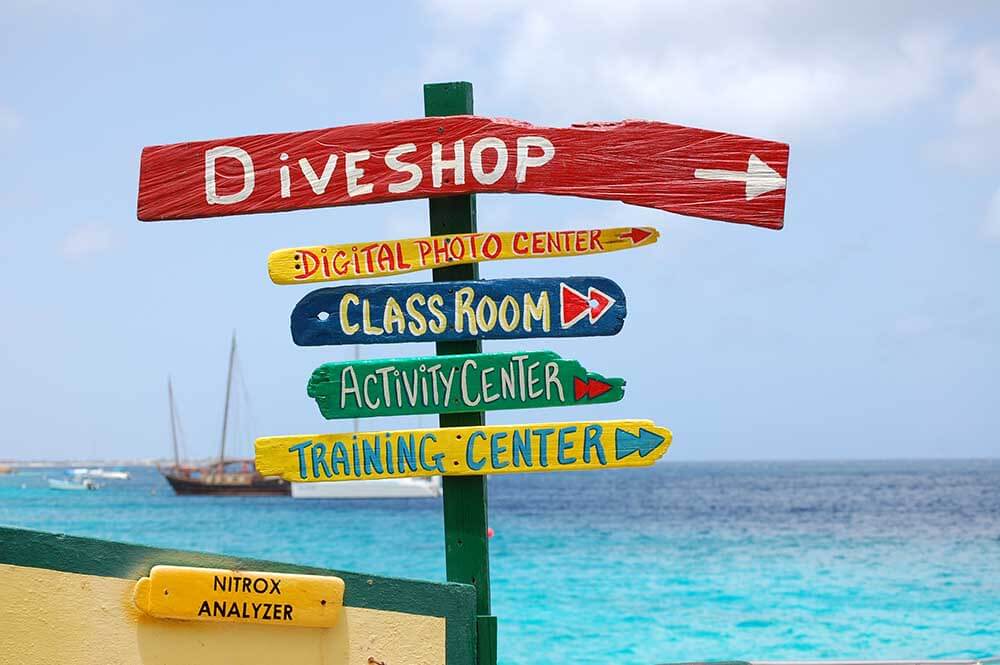
Learning to dive is not particularly difficult, but it helps to know what you’ll actually be doing during your entry-level scuba diving course, as a little bit of prior preparation may make it just a bit more enjoyable
Entry-level scuba diving courses have three main components – dive theory, confined water skill training, and open water practical assessment.
Courses typically take between 20-30 hours – plus another 8-12 hours of independent study – much of which is dependent on local logistics and student availability. In a typical resort-based environment this will be take 3-5 days, but the time can be spread over several weeks – even months – for students who are learning to dive at weekends or in the evenings after work.
or is some leeway about how the components of the courses are arranged, which may be based on what facilities are available to the dive centre. If the dive centre is close to a pool or shallow-water training environment and adjacent to the open water environment, then it is easy to mix all three components together, subject to standards of ordering mandated by the training agencies.
In other locations, where pools, boats or classrooms may only be available at specific times or dates, the dive course may be wholly sequential: a day of knowledge development followed by a day of pool training followed by open water assessment dives on the last two days of the course.
Logistics may have a substantial impact on the timing of the course, and for this reason it is worth noting that a three-day course does not necessarily mean that components have been skipped. Armchair experts can argue about that until the cows have come home – but with logistical convenience and a good student who has prepared well in advance, you really can learn to dive safely in three days.
DIVE Magazine’s Learning to DIVE series
Scuba diving courses part 1 – knowledge development

Scuba diving knowledge development covers the basics of the physics and physiology of diving; how to use and care for dive equipment; the skills you need to sustain yourself underwater; and important information about the environment and how to best protect it.
Do not be deterred! You do not need to hold a PhD – nor even a high school diploma – in any of these subjects. Remember that entry-level courses across the board are designed to be taken from the age of 10 and up, so there is no need to worry if your talents lie in other directions.
For example: you do not have to understand the physics behind the gas laws to learn that air spaces contract under pressure and expand as the pressure is released. You just need to know that it happens and how to deal with it by equalising – or ‘popping’ – your ears; adding or removing air from the buoyancy ‘jacket’ as you descend and ascend; and why you must never hold your breath underwater.
Similarly, in the same way you don’t need to understand the workings of an engine in order to drive a car, you don’t need to know in detail how a set of regulators (the bit you breathe from) works, only how to check them, use them, and properly care for them.
It is important that the knowledge development part of a dive course is not rushed or skipped. Some people view it as a sort of necessary evil before getting in the water – and nobody wants to go on holiday to go back to school – but it is essential for your safety, your enjoyment, and the preservation of the environment in which you will be diving.
Make sure you understand what you are learning, and don’t just find the right bit of theory which answers a particular question.
The rise of eLearning
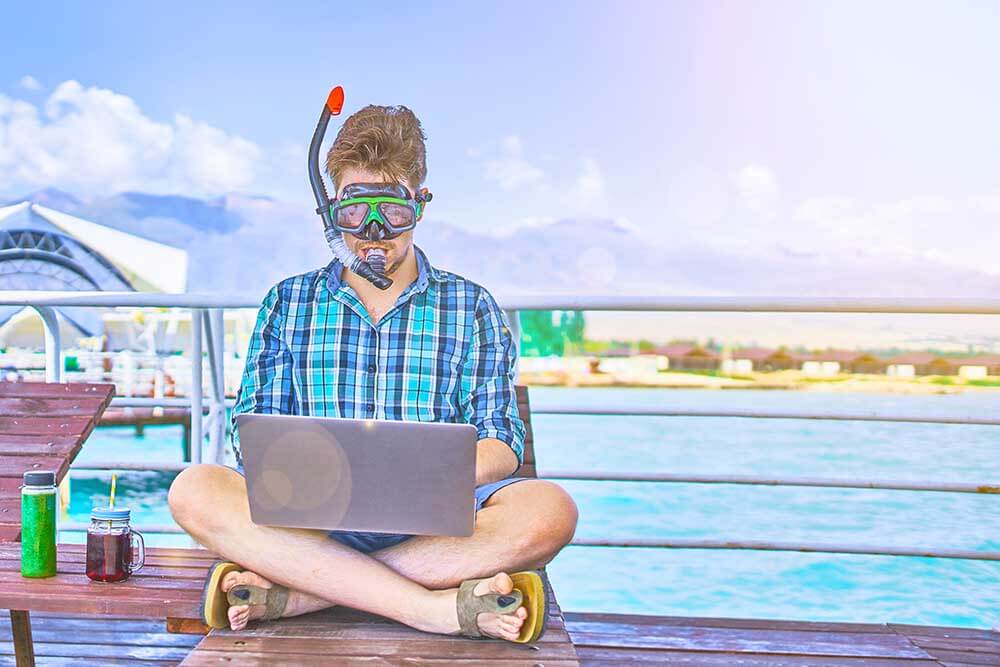
Most dive training programmes offer their knowledge development sessions through online courses, and eLearning has become an immense boon to the dive industry, allowing instructors to spend more time working with their students on in-water dive skills than sitting in classrooms.
It works best if students are able to learn in advance, in their own time, before starting the practical side of their dive courses. If you are certain that you are ready to commit to an entry-level training programme, then most instructors would recommend that, if possible, you subscribe to an online programme several weeks before starting the main event.
If you’re not certain (check out this previous article if you’re not), or you only choose to start a course once you’re on holiday, then you will need to complete the knowledge development while you’re there, regardless of whether you opt for eLearning or a good old-fashioned paper book. That might be in a dive centre classrooom or reading the course material while sipping cocktails under a warm and starlit sky by the pool – but it still means you are spending part of your holiday studying.
Whichever route you decide to take, it is most important you commit to the learning. I spent a lot of my instructional career teaching other dive professionals, and one question I was asked several times during Divemaster courses was ‘Crowley, where do I find all this information?’ – to which I would respond by holding up a copy of my PADI Open Water manual!
Scuba diving courses part 2 – practical ‘confined water’ skill training
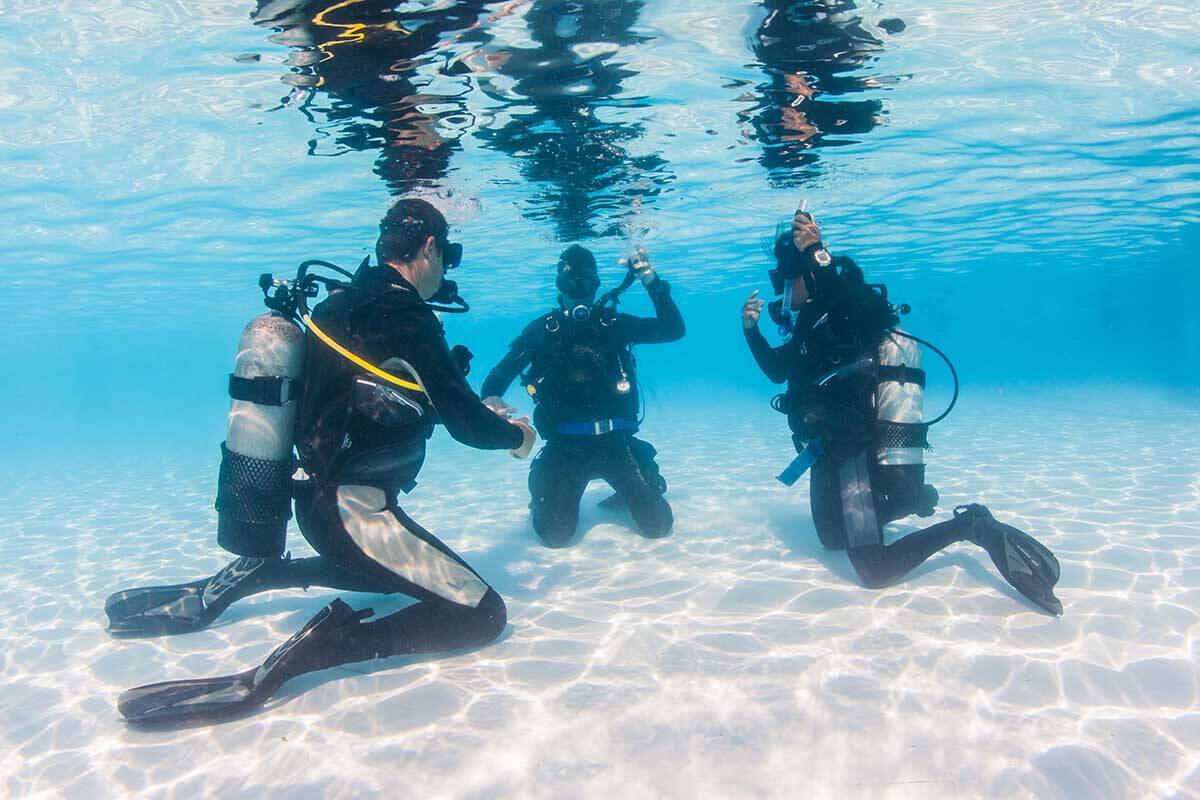
The skill training section is referred to as the ‘confined water’ or ‘pool’ training – in that it can happen in a pool, or in a place in the open water that has ‘swimming pool-like conditions’: good visibility and little to no current, although (generally speaking) more fish.
This is where your instructor will brief you on the skills you will learn in that session, demonstrate them in the water and have you practice and repeat the skill until you are able to do so comfortably and without assistance.
You will learn safety drills such as what do if you or your buddy should run out of air; practical skills such as clearing the mask of water if it leaks; buoyancy skills such as learning how to control your position through your breathing alone; and the universal sign language used by divers.
Some of the skills are quite easy, but some of them – such as having to remove and replace your mask underwater – can often take hours to comfortably repeat.
The first and most basic skills are usually introduced in water which is shallow enough to stand up in with your upper body completely out of the water. It’s an excellent and easy introduction to the diving environment.

If you are at any point not comfortable then you can just stand up and take a moment to recover. It often takes some time to get the hang of even the simplest of tasks and you should never let this get the better of you. Relax, rest, repeat.
Even if you get something right first time, make sure you don’t stop at just once, and never be afraid to ask your instructor for more time or for extra help. There can sometimes be a certain amount of peer pressure in a group where some may pick up the skills more quickly than others, but no matter how much you may feel you have to give into it, just don’t.
Always be honest with your problems and always ask for assistance or extra explanation if you need it. The skills progress from easy to more challenging, and you’ll be expected to demonstrate your ability to perform those skills in much deeper water during the practical application open water dives.
The great kneeling on the floor debate.
Over the last ten years or so, there has been a much greater emphasis on learning to perform skills ‘in the water column’, which is to say, not kneeling or sitting on the bottom of the pool or seabed. This is immensely beneficial to scuba diving overall, because when you are in the open water, there may be nothing available to support you if you need to adjust your equipment or deal with a problem.
There are some, however, who think that any training – even the most basic introductory training – conducted in a stationary, seated or kneeling position is invalid, and representative of poor instructors following poor training standards.
I disagree very strongly with this. The ultimate aim is, of course, to be able to perform all skills mid-water, but remaining in contact with the bottom during early training and practice is often necessary to develop those skills before progressing to the water column.
It’s the same as taking your first nervous seat behind the steering wheel of a car in a car park, rather than on a busy main road. The aim is to drive comfortably on the busy main road, but it helps if you know how to work the sticks and pedals first.
Scuba diving courses part 3 – practical ‘open water’ application

The ‘Open Water’ or ‘Checkout’ dives are where you finally get to experience a proper diving environment and demonstrate your ability to control your buoyancy, movement through the water, communication and air-checking skills, deal with simple equipment problems and respond to simulated emergency situations.
Depending on agency and location, there will be between four to six deep water dives. All the skills learned in the shallow water sessions will be assessed in a deeper water environment, while you also become familiar with the new world you are entering. The utility of those skills will become apparent very quickly as you feel the effects of the increased pressure, and the theory and training will remind you what you need to do to compensate.
Many divers have an occasional wobble, but you may be as deep as 18m/60ft during these dives, and popping to the surface if you have a problem is no longer an option. There will be an instructor to look after you, of course, but it’s important that you really do get control of your skills before you finish the shallow-water training.
One particularly notorious skill – in which student divers must remove, replace and clear their masks underwater – is often the cause of problems during training. It is never pleasant, but it can lead to outright panic in somebody who is not comfortable with the sensation of water on their maskless face.
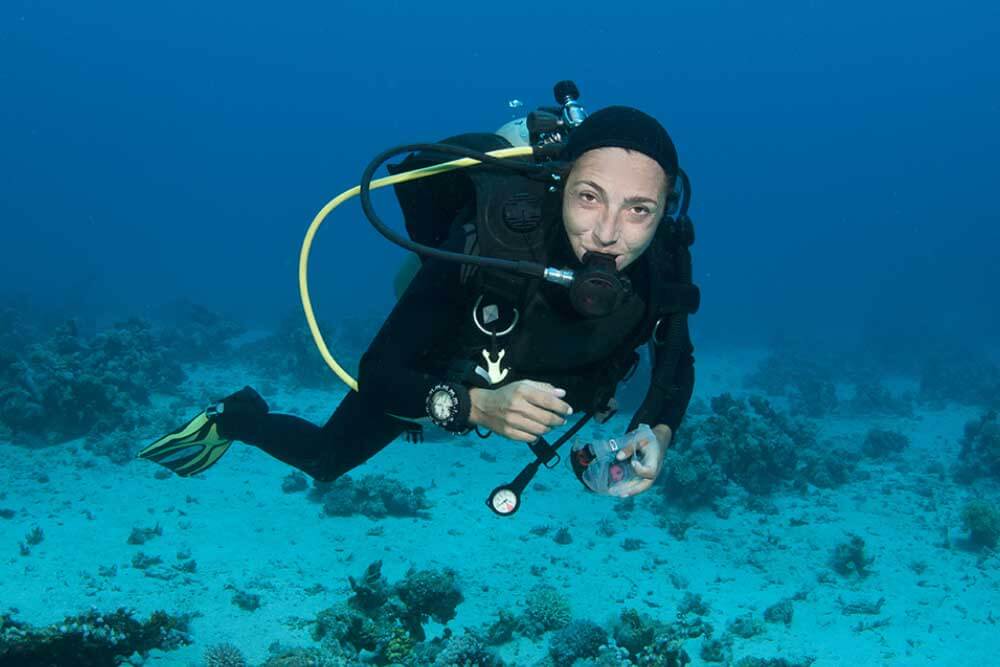
If you at all feel uncertain, or uncomfortable, about anything, make sure you talk to the instructor before heading into deeper water. Do not be afraid, nor ashamed, to opt for an extra day of shallow-water practice and remediation if necessary.
As mentioned in the introduction, there can be some leeway in how course components are arranged within a beginner-level dive programme, which means you the first deep-water dives can take place before all the pool training has been finished. This depends on the agency, the instructor, the student’s progress and local logistics, but it’s worth pointing out that it’s perfectly normal.
It’s also worth pointing out that the deep-water dives – especially the final two – may take place from a boat, which can be an interesting experience for the uninitiated. Speak with your instructor if you have concerns and the potential for sea-sickness.
It may be a little nerve-wracking jumping into deep water for the first time, and it’s very certainly distracting with all the underwater fish action, but pay attention to your instructors and buddies, remember your training and keep your mind on what you’re doing.
The swimming test
At some point, you will have to take a swimming test. The standard is to swim 200 metres unaided, although some programmes allow a 300m swim aided by mask, fins and snorkel. You may also be required to ‘maintain yourself comfortably’ at the surface for ten minutes by floating or treading water.
As I always say: you do not have to be an Olympic athlete, nor do you have to be a particularly good swimmer, you just have to be able to fulfill those requirements comfortably and without undue physical or mental stress.
Although the 300m snorkel swim may be more attractive, it’s not always possible, so assume you will be expected to swim the 200m version without swimming aids.
If you can’t do it, you won’t pass the course, so if you feel that the requirements are beyond your current level of fitness and swimming ability, then some pool time prior to your holiday is essential.
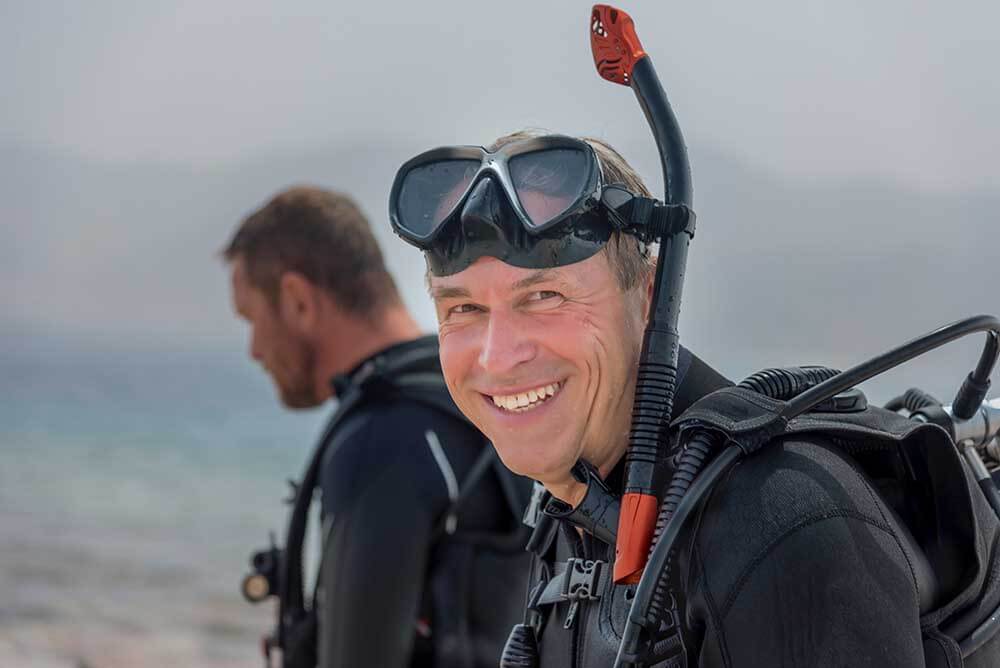
Conclusion
Every entry-level training program is designed to provide you with the knowledge and skills that you will need to be a competent beginner-level diver.
Regardless of which agency’s course you have subscribed to, your instructor will have been trained to provide that instruction according to a strict set of rules and standards. There is flexibility to the course outline, but certain requirements must be met before certain progress is possible.
This is not to say that every course will be perfect and it’s – fair to say – neither is every instructor.
In the next article, we’ll have a look at some of the various trading agencies and steps you can take to go about reassuring yourself that the dive centre and the instructor who will be teaching you are right for the job.
- Suunto launches new Nautic & Nautic S dive computers - 18 November 2025
- Generations Below – a father-son team working to build a global underwater treasure hunt - 11 November 2025
- Eyewitness speaks out about Dylan Harrison’s death - 11 November 2025


